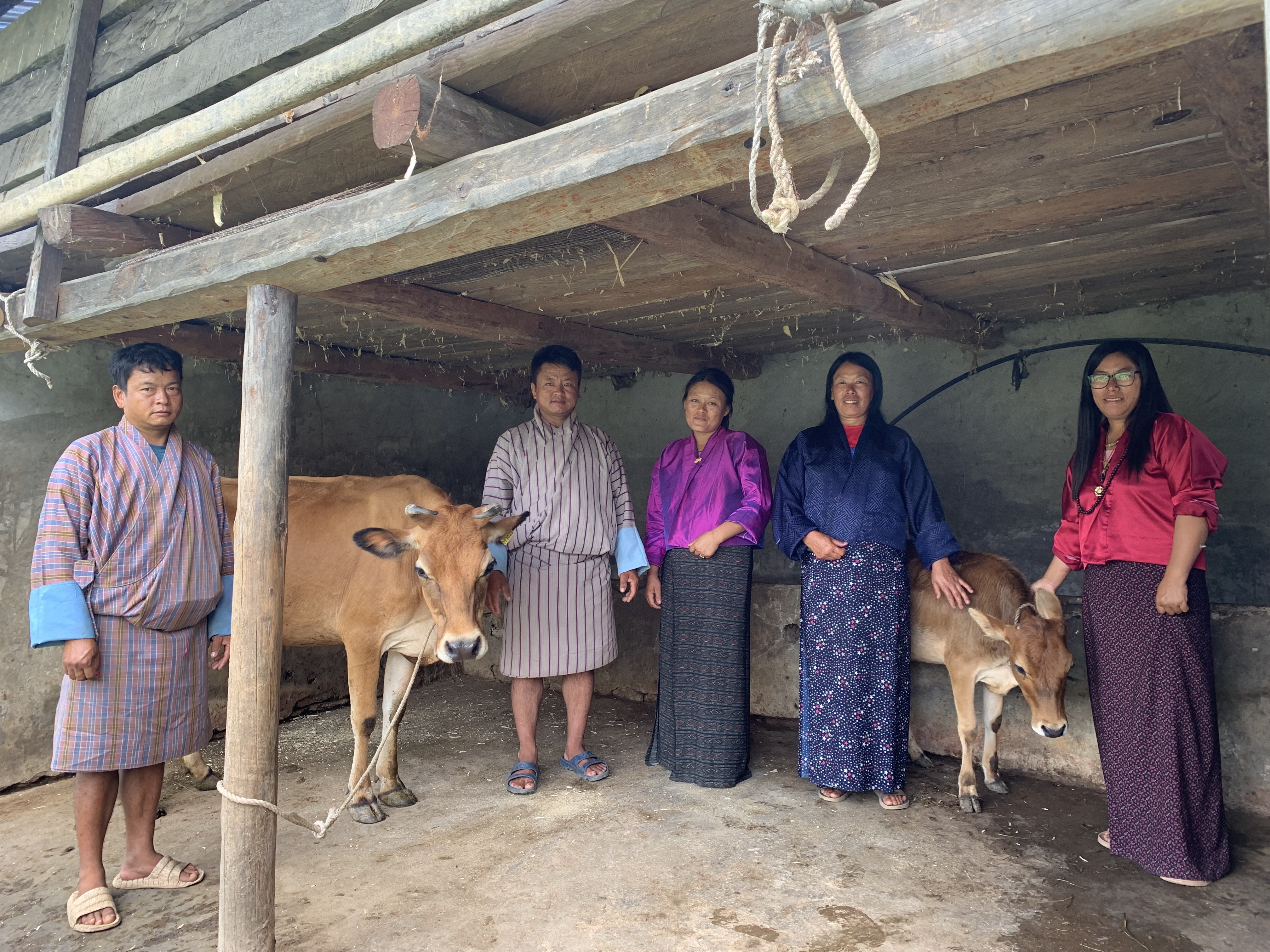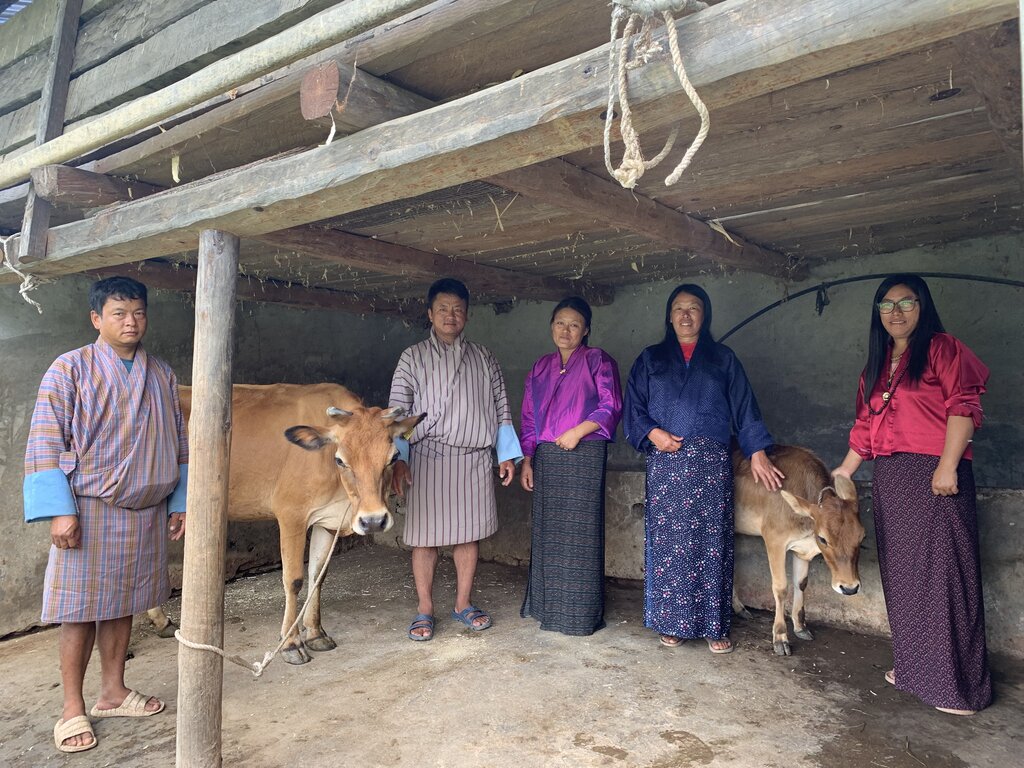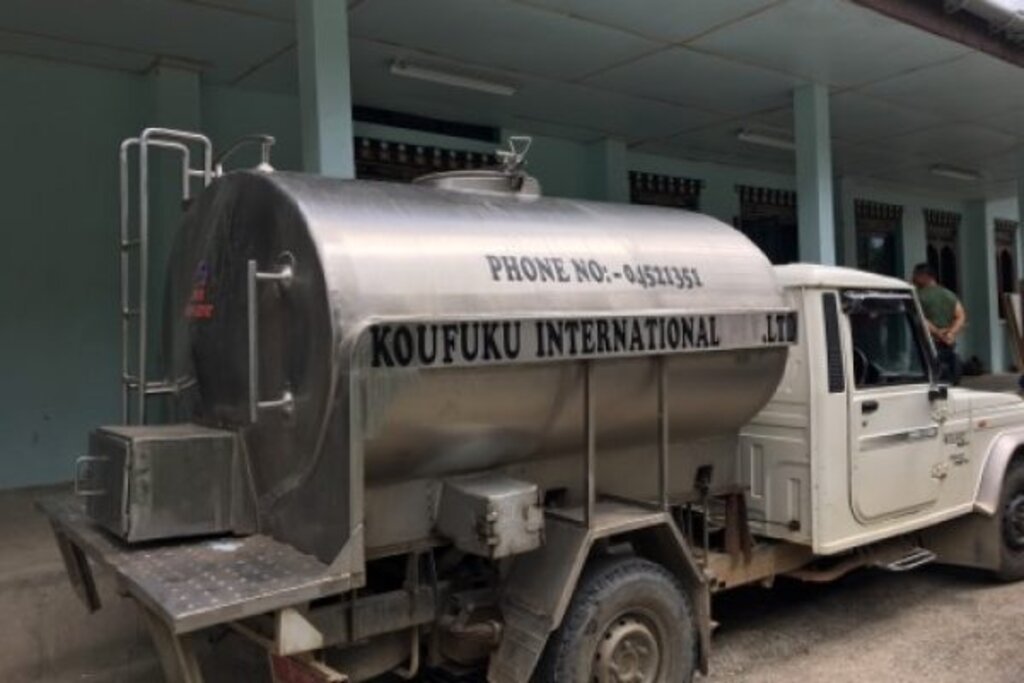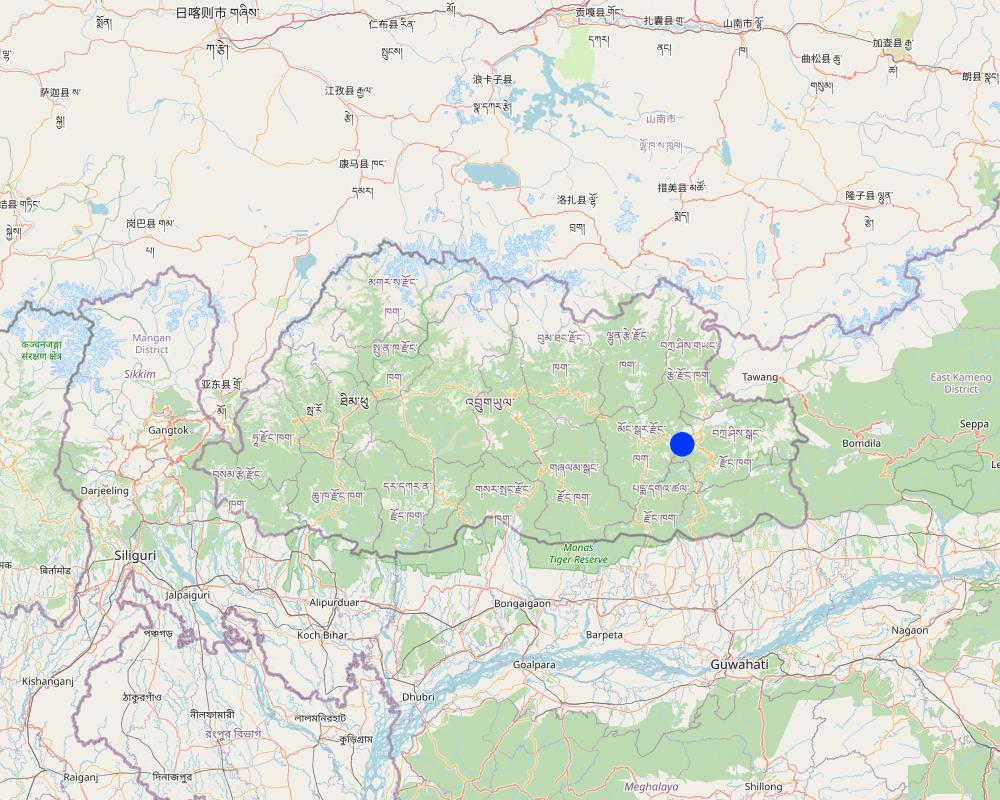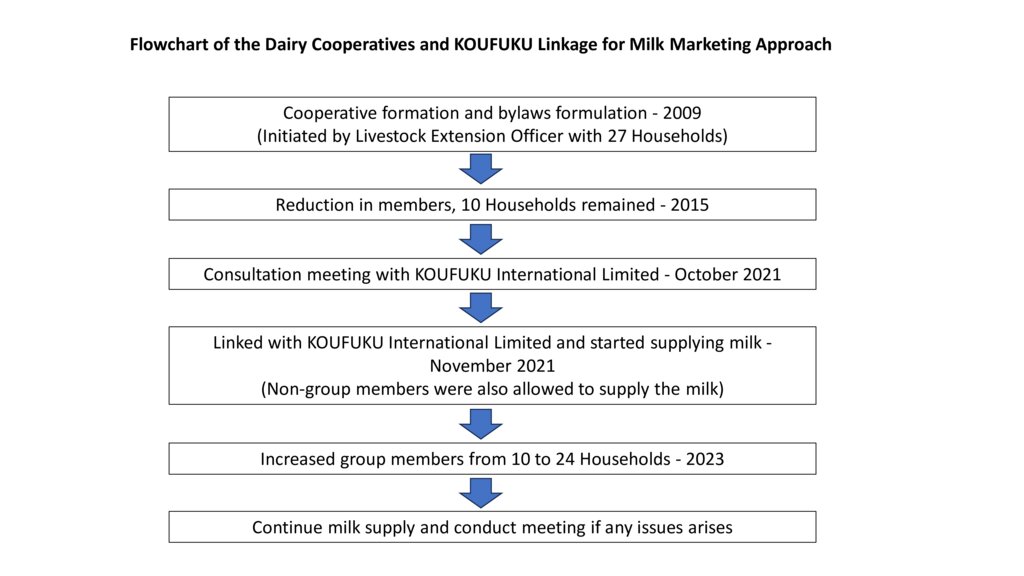Dairy Cooperatives and KOUFUKU linkage for milk marketing [Bhutan]
- Creation:
- Update:
- Compiler: Nima Dolma Tamang
- Editor: Haka Drukpa
- Reviewers: William Critchley, Rima Mekdaschi Studer
approaches_6889 - Bhutan
View sections
Expand all Collapse all1. General information
1.2 Contact details of resource persons and institutions involved in the assessment and documentation of the Approach
Key resource person(s)
land user:
Kelzang
17711512
Tshedung Village, Rizor Chiwog, Udzorong Gewog, Trashigang Dzongkhag
Bhutan
land user:
Tenzin Yeshey
17419479
Tshedung Village, Rizor Chiwog, Udzorong Gewog, Trashigang Dzongkhag
Bhutan
land user:
Karma
77737250
Tshedung Village, Rizor Chiwog, Udzorong Gewog, Trashigang Dzongkhag
Bhutan
land user:
Zangmo Tshering
77201103
Tshedung Village, Rizor Chiwog, Udzorong Gewog, Trashigang Dzongkhag
Bhutan
land user:
Choden Jigme
17725834
Tshedung Village, Rizor Chiwog, Udzorong Gewog, Trashigang Dzongkhag
Bhutan
Name of project which facilitated the documentation/ evaluation of the Approach (if relevant)
Strengthening national-level institutional and professional capacities of country Parties towards enhanced UNCCD monitoring and reporting – GEF 7 EA Umbrella II (GEF 7 UNCCD Enabling Activities_Umbrella II)Name of the institution(s) which facilitated the documentation/ evaluation of the Approach (if relevant)
National Soil Services Centre, Department of Agriculture, Ministry of Agriculture & Livestock (NSSC) - Bhutan1.3 Conditions regarding the use of data documented through WOCAT
When were the data compiled (in the field)?
15/07/2023
The compiler and key resource person(s) accept the conditions regarding the use of data documented through WOCAT:
Yes
1.4 Reference(s) to Questionnaire(s) on SLM Technologies
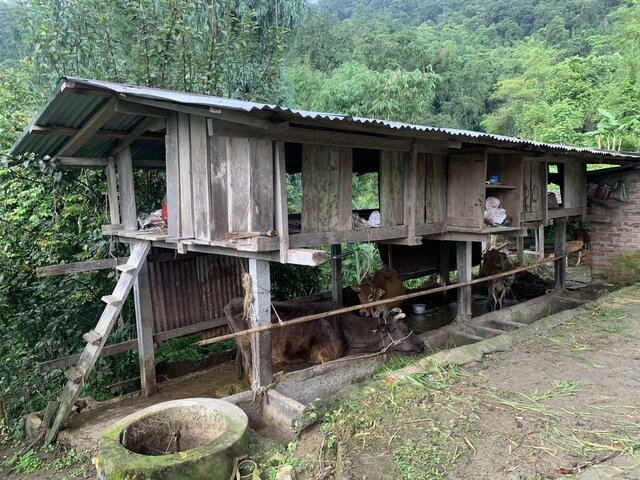
Improved Dairy Shed [Bhutan]
An improved dairy shed in Bhutan is characterized by concrete floors, cement pillars and troughs, enough sunlight and ventilation, adequate water, ample space for cattle movement, as well as urine and dung collection gutters and a farmyard manure collection area.
- Compiler: Tshering Yangzom
2. Description of the SLM Approach
2.1 Short description of the Approach
This approach links dairy cooperatives with a dairy plant, KOUFUKU International Limited (KIL), for milk marketing. It is an established dairy value chain that addresses milk and dairy product marketing issues and improves the livelihoods of many small dairy farmers in eastern Bhutan.
2.2 Detailed description of the Approach
Detailed description of the Approach:
This approach links dairy cooperatives with a dairy plant, KOUFUKU International Limited (KIL), for milk marketing. It is an established dairy value chain that addresses milk and dairy product marketing issues and improves the livelihoods of many small dairy farmers in eastern Bhutan. The approach encompasses milk cooperatives, collection centres, milk transport vans, and the processing unit operated by KIL. Currently, milk is supplied to the company by approximately 22 milk cooperatives, each consisting of land users engaged in dairy farming. This documentation focuses on the linkage between KIL and one such cooperative named Samphel Chirphen Jersey Detshen of Udzorong Gewog in Trashigang Dzongkhag.
At the heart of the system are collection centres, strategically placed at each dairy cooperative and equipped with chilling machines. Managed by the dairy cooperatives, these centres serve as crucial points for milk collection. A dedicated milk transport van and driver is arranged to facilitate the transportation of milk from individual land users to the collection point, and onward to the processing unit. Designed with insulation, the van ensures the quality of the milk is maintained, preventing deterioration during transit. The pricing structure for land users is influenced by their choice in milk collection and transport: those opting for the company's services receive a lower price per litre.
The KIL processing unit, situated in Chenary, Trashigang Dzongkhag, is a subsidiary of Druk Holding and Investments Limited (DHI). This unit produces a variety of processed milk products, including "Druk Zambala Cheese," salted and non-salted butter, stirred yogurt, gouda cheese, and cottage cheese. This approach improves the livelihoods of land users, encouraging cooperative members to increase milk production which ultimately increases cash income.
For KIL, the company's involvement aims to augment processing capacity. Despite having the potential to process 4000 litres of milk daily, only 44% of this capacity was utilized as of 2021. The approach embraces an inclusive model, involving smallholder land users in cooperative formation and connecting them to the market, making it a successful value chain intervention.
The implementation method of Samphel Chirphen Jersey Detshen employs a consultative approach, engaging various stakeholders such as the Gewog Livestock Extension Officer, Dzongkhag Livestock Officer, CARLEP officials, and a representative from KIL. This collaborative method enables land users to voice their needs, ensuring decisions that benefit the community.
The stages of implementation involve the initiation of cooperative formation driven by awareness created by the Livestock Extension Officer. Group formation facilitates resource-sharing and reduces workload of land user. Further, subsidies and incentives support from the government are directed towards the cooperative rather than individual land users, emphasizing the importance of forming cooperatives to maximize benefits. The dairy cooperative members were supported to construct improved cattle sheds and biogas plants to improved livestock rearing.
Initially, the Samphel Chirphen Jersey Detshen faced marketing challenges, prompting government intervention to connect them with KIL. Consultations resulted in an agreement where land users committed to supplying a minimum of 100 litres per day at a negotiated rate of Nu. 35 per litre, establishing KIL as their end market. Subsequently, improved cattle breeds were acquired, and the cooperatives increased their daily milk supply from 71 to 280-300 litres. Stakeholders, including Gewog Livestock Extension Officer, Dzongkhag Livestock Officer, Gewog Officials, and CARLEP-IFAD, play pivotal roles in providing technical guidance, subsidies, and funding. Regular monitoring ensures the success of the activity.
In summary, this approach benefits land users by enhancing marketing services and providing sustainable sources of household income – and indirectly improves SLM through encouraging better husbandry of dairy cattle and associated biogas plants.
2.3 Photos of the Approach
2.5 Country/ region/ locations where the Approach has been applied
Country:
Bhutan
Region/ State/ Province:
Trashigang Dzongkhag
Further specification of location:
Tshedung Village, Rizor Chiwog, Udzorong Gewog
Map
×2.6 Dates of initiation and termination of the Approach
Indicate year of initiation:
2021
2.7 Type of Approach
- recent local initiative/ innovative
2.8 Main aims/ objectives of the Approach
The approach aims to establish an efficient marketing system of the milk by creating a linkage between the land user and the milk processing unit. it will also contriutes to increased in income and improvement of land users' livelihoods.
2.9 Conditions enabling or hindering implementation of the Technology/ Technologies applied under the Approach
social/ cultural/ religious norms and values
- enabling
Technologies under the approach such as biogas and improved diary sheds are environment friendly which complements the religious belief of Buddhism through being socially just.
availability/ access to financial resources and services
- enabling
During the construction of a biogas plant, land users were accessible to the loan from Bhutan Development Bank Limited (BDBL). BDBL focuses on rural prosperity and provides funds for agricultural purposes. Subsidy support is provided by the government.
institutional setting
- enabling
The institutional setting enabled the implementation of technology as there were only a few land users trained for the construction of biogas. The trained land user from the group shared the skills and knowledge with other land users during the installation of the biogas plant.
collaboration/ coordination of actors
- enabling
Land users shared ideas, and workloads, and made collective decisions in the meeting to resolve the issues.
knowledge about SLM, access to technical support
- enabling
Implementation of improved cattle sheds and biogas enriched the land user with the knowledge of soil nutrient management. For example, in the past, the land users never collected cow urine due to poor cattle shed design, now they can collect cattle urine and use it as a nitrogen source in vegetable fields.
markets (to purchase inputs, sell products) and prices
- enabling
The linkage reduced the workload of the land users to market the produce as the milk collection was done from the land users' house.
workload, availability of manpower
- enabling
The approach led to reduced workload as each land user need not reach the milk at the collection centre. Further with the cemented cattle shed, maintaining sanitation and cleaning the shed requires less time.
3. Participation and roles of stakeholders involved
3.1 Stakeholders involved in the Approach and their roles
- local land users/ local communities
A total of 34 members (25 male and 9 female), aged between 35 to 50 years old from Samphel Chirphen Jersey Detshen were involved in the approach.
Produce and supply fresh milk to milk processing unit.
Elected members such as Chairman, Secretary and Treasures to function as per bylaws.
- SLM specialists/ agricultural advisers
Gewog Livestock Officer and Dzongkhag Livestock Officer
Provide technical inputs, monitor the activities and progress of the group and take issues that are not resolved within the cooperative to higher forums such as Gewog and Dzongkhag meetings.
- private sector
KOUFUKO International Limited
Purchase milk from the land users and provide support in transportation and marketing.
- local government
Gup, Tshokpa, Mangmi
Monitor group activities and allocate gewog funds if required for the group. For example, the Gewog fund of Nu. 10,00,000/- (Ten hundred thousand) was allocated to purchase improved cattle breeds (jersey) for the land users where a 70% subsidy was provided and only 30% of the total cost was borne by land users.
3.2 Involvement of local land users/ local communities in the different phases of the Approach
| Involvement of local land users/ local communities | Specify who was involved and describe activities | |
|---|---|---|
| initiation/ motivation | external support | Gewog Livestock Extension Officer motivated the land users to form cooperatives by creating awareness of the benefits involved in working in a group rather than individually. |
| planning | interactive | All the stakeholders (Gewog Livestock Extension Officer, Dzongkhag Livestock officer, representatives of the KOFUKU International Limited and CARLEP-IFAD officials) were involved in the planning process. |
| implementation | interactive | All the stakeholders with related expertise were involved in the implementation process. For example, the Dzongkhag engineer, Gewog Livestock Extension Officer, Dzongkhag Livestock officer, Gup, CARLEP-IFAD officials and land users were involved in the construction of the milk collection shed, |
| monitoring/ evaluation | interactive | External monitoring is done by CARLEP-IFAD officials, the Gewog Livestock Extension Officer, Dzongkhag Livestock Officer. Internal monitoring is done by Thrizin to ensure the minimum milk capacity (100 litres) is met. |
3.3 Flow chart (if available)
Description:
The flowchart is developed in consultation with the land users.
Author:
Nima Dolma Tamang
3.4 Decision-making on the selection of SLM Technology/ Technologies
Specify who decided on the selection of the Technology/ Technologies to be implemented:
- mainly SLM specialists, following consultation with land users
Explain:
Implementation of the biogas plants and improved cattle shed construction was introduced by the Dzongkhag Livestock Officer in consultation with the land users.
Specify on what basis decisions were made:
- personal experience and opinions (undocumented)
4. Technical support, capacity building, and knowledge management
4.1 Capacity building/ training
Was training provided to land users/ other stakeholders?
Yes
Specify who was trained:
- land users
If relevant, specify gender, age, status, ethnicity, etc.
There were 34 members in the cooperative consisting of 25 male and 9 female, aged between 35 to 50 years old all belonging to Sharchop ethnicity.
The gender composition is based on the head of the household registered in the census although all the family members (both male and female) are involved in the activity.
Form of training:
- farmer-to-farmer
- demonstration areas
- courses
Subjects covered:
Cattle shed and biogas plant construction and their benefits. Fodder grass plantations such as napier, super napier (Pakchong), and others.
4.2 Advisory service
Do land users have access to an advisory service?
Yes
Specify whether advisory service is provided:
- on land users' fields
- at permanent centres
Describe/ comments:
The Gewog Extension Officer is involved in providing advisory services based on the need.
4.3 Institution strengthening (organizational development)
Have institutions been established or strengthened through the Approach?
- yes, moderately
Specify the level(s) at which institutions have been strengthened or established:
- local
Describe institution, roles and responsibilities, members, etc.
The institution is strengthened through the approach as there were only 10 members in the cooperative in 2022 which increased to 24 as of 2023.
Specify type of support:
- capacity building/ training
Give further details:
Training provided by DLO for biogas construction
4.4 Monitoring and evaluation
Is monitoring and evaluation part of the Approach?
Yes
Comments:
External monitoring is done by CARLEP-IFAD officials, the Gewog Livestock Extension Officer, the Dzongkhag Livestock Officer and Gewog Officials. The monitoring officials conduct the site visits to see the implementation of an improved dairy shed, improved cattle breeds, fodder grass plantation and biogas plant. The monitoring is mainly done to meet the objective of the funding agency and service providers i.e. to increase milk productivity and improve the livelihood of the land users.
If yes, is this documentation intended to be used for monitoring and evaluation?
No
4.5 Research
Was research part of the Approach?
No
5. Financing and external material support
5.1 Annual budget for the SLM component of the Approach
Comments (e.g. main sources of funding/ major donors):
There is no annual budget allocated for the approach as the linkage is well established. The land users are equipped to sustain themselves. However, if new challenges arise, the budget is sought from various stakeholders.
5.2 Financial/ material support provided to land users
Did land users receive financial/ material support for implementing the Technology/ Technologies?
Yes
If yes, specify type(s) of support, conditions, and provider(s):
1. Financial support
Nu. 11,700/- (USD 140.54) provided for biogas construction for individual households
70% subsidy for procurement of improved cattle breeds
2. Equipment
70% subsidy was provided for the deep fridge for individual household and 3 large for the collection point (30-40 litres) 30% of the amount was paid by land users. Doner funded 100% for the milk collection can, butter churner, and chiller machine.
3. Construction materials per household
Donor funded 100% for the biogas construction materials 8 bags of cement, metal, pipe, stove
Donor funded 100% for the improved cattle shed construction materials 18 bags of cement, 18 number of CGI sheets, half truck sand.
5.3 Subsidies for specific inputs (including labour)
- equipment
| Specify which inputs were subsidised | To which extent | Specify subsidies |
|---|---|---|
| machinery | fully financed | Donor funded 100% for the milk collection can, butter churner, and chiller machine. |
| Deep fridge | partly financed | 70% by the donor CARLEP and 30% by the land user |
- agricultural
| Specify which inputs were subsidised | To which extent | Specify subsidies |
|---|---|---|
| seeds | fully financed | Fodder seeds were fully financed |
- construction
| Specify which inputs were subsidised | To which extent | Specify subsidies |
|---|---|---|
| Cement, matal, pipe | fully financed | 100% financed for the construction of biogas and cattle shed |
- infrastructure
| Specify which inputs were subsidised | To which extent | Specify subsidies |
|---|---|---|
| Cattle shed | fully financed | 18 bags of cement, 18 CGI sheet, half truck sand. |
If labour by land users was a substantial input, was it:
- voluntary
5.4 Credit
Was credit provided under the Approach for SLM activities?
Yes
Specify conditions (interest rate, payback, etc.):
Land users in the group can avail loans of up to Nu. 20,000 (USD 240.25) loan payable on quarterly basis for 3 years.
Specify credit providers:
Bhutan Development Bank Limited - A bank focusing on rural development.
Specify credit receivers:
Land users
5.5 Other incentives or instruments
Were other incentives or instruments used to promote implementation of SLM Technologies?
No
6. Impact analysis and concluding statements
6.1 Impacts of the Approach
Did the Approach empower local land users, improve stakeholder participation?
- No
- Yes, little
- Yes, moderately
- Yes, greatly
The approach improved farm income, knowledge and skills empowering land users to deal with difficult situations efficiently.
Did the Approach enable evidence-based decision-making?
- No
- Yes, little
- Yes, moderately
- Yes, greatly
Yes, to cite an example, the land users learned that super napier (Napier Pakchong 1 which is a hybrid between Pennisetum purpureum and Pennisetum americanum cv. Pakchong 1) gives more milk than the guatemala. Therefore, they opted for plantation of super napier than guatemala.
Did the Approach help land users to implement and maintain SLM Technologies?
- No
- Yes, little
- Yes, moderately
- Yes, greatly
Yes, the approach improves market linkage and indirectly encourages land users to increase milk production due to an assured market. The byproduct of the approach (cow dung) can be used to develop farm yard manure (FYM) and biogas plants ultimately improving soil quality, production of alternative energy source for cooking and heating.
Did the Approach mobilize/ improve access to financial resources for SLM implementation?
- No
- Yes, little
- Yes, moderately
- Yes, greatly
The approach enabled stakeholders to mobilize funds and provide subsidies and financial resources to implement SLM. The land users got Nu. 20000/- loan from BDBL to construct improved diary shed.
Did the Approach improve knowledge and capacities of land users to implement SLM?
- No
- Yes, little
- Yes, moderately
- Yes, greatly
Through the approach, the land users were trained on SLM implementation increasing their knowledge and skills.
Did the Approach improve knowledge and capacities of other stakeholders?
- No
- Yes, little
- Yes, moderately
- Yes, greatly
The cooperative is supported by various stakeholders in terms of technical and advisory services. When there is any issues faced by the land users, they turn to the stakeholders for support, where the stakeholders need to develop a method to solve their issues leading to improved knowledge of the stakeholders.
Did the Approach build/ strengthen institutions, collaboration between stakeholders?
- No
- Yes, little
- Yes, moderately
- Yes, greatly
The approach improved collaboration between stakeholders including CARLEP-IFAD, Gewog and Dzongkhag officials and KOUFUKU International Limited company.
Did the Approach mitigate conflicts?
- No
- Yes, little
- Yes, moderately
- Yes, greatly
In the past, there were social conflicts in the group as there were a few individuals who failed to do their duty of collecting milk and turning up for other group activities leading to social conflict and misunderstanding. With the establishment of linkage with the processing unit, marketing is facilitated by the company leading to a significant reduction in the social conflict.
The group is equity focused, where economically disadvantaged land users are given priority to join the group. Although milk collection is done from all.
Did the Approach improve gender equality and empower women and girls?
- No
- Yes, little
- Yes, moderately
- Yes, greatly
Any interested land users irrespective of their gender can be part of the cooperative. The greater number of males in the group member list is due to the majority of the men being head of the household. While implementing, both the parties are given equal opportunity.
Did the Approach encourage young people/ the next generation of land users to engage in SLM?
- No
- Yes, little
- Yes, moderately
- Yes, greatly
Although there are opportunities for the youths to open a large-scale dairy farm with a secured market. There were no interested youth from the community to take up dairy farming. This could be due to better opportunities and facilities available in the town than village setting. However, there were few youth entrepreneurs from the Dzongkhag involved in large-scale dairy farming.
Did the Approach lead to improved food security/ improved nutrition?
- No
- Yes, little
- Yes, moderately
- Yes, greatly
The approach provided a sustainable income source increasing the land users' buying capacity for nutritious foods.
Did the Approach improve access to markets?
- No
- Yes, little
- Yes, moderately
- Yes, greatly
There is a significant improvement in the milk market as the buyer comes to the land users' doorstep to collect milk.
Did the Approach lead to more sustainable use/ sources of energy?
- No
- Yes, little
- Yes, moderately
- Yes, greatly
Yes, the approach led to the implementation of biogas technology which is one of the sustainable sources of energy.
Did the Approach lead to employment, income opportunities?
- No
- Yes, little
- Yes, moderately
- Yes, greatly
On average individual household generates Nu. 12000/- by selling milk. Thereby, improving farm income and motivating land users to engage in livestock farming ultimately generating employment.
6.2 Main motivation of land users to implement SLM
- increased production
The linkage improved market access to the land users which motivated them to increase production due to an assured market. Implementation of biogas, improved diary shed and FYM improved land users' soil quality and increased crop productivity.
- increased profit(ability), improved cost-benefit-ratio
The cooperative should supply a minimum of 100 litres of milk to the Company. Therefore, it enabled land users to source support from various stakeholders to increase productivity such as funding for fodder grass slips, subsidy for the purchase of improved breeds of cattle and other supports ultimately leading to increased productivity and profit for the land users.
6.3 Sustainability of Approach activities
Can the land users sustain what has been implemented through the Approach (without external support)?
- yes
If yes, describe how:
Support needed for the establishment of the linkage is completed. Hereafter, the land users can sustain themselves without external support.
6.4 Strengths/ advantages of the Approach
| Strengths/ advantages/ opportunities in the land user’s view |
|---|
| The major strength of the approach is milk marketing where land users get access to the market without having to worry about transportation. On the other hand, KOUFUKU International Limited can increase its production capacity of milk products. |
| Forming a cooperative and working together enabled land users to avail various support from the government as majority of the support is provided to the group than individual households. |
| The approach improved household income leading to improved livelihoods of the land users. |
| Strengths/ advantages/ opportunities in the compiler’s or other key resource person’s view |
|---|
| Encourages other land users to form milk cooperatives. Udzorong Gewog is one of the remote areas of Trashigang Dzongkhag and the ability to establish linkage and generate income from livestock farming would encourage other land users from different chiwog and gewogs to form milk cooperatives. This would ultimately improve the living standard of the community and country. |
6.5 Weaknesses/ disadvantages of the Approach and ways of overcoming them
| Weaknesses/ disadvantages/ risks in the land user’s view | How can they be overcome? |
|---|---|
| The land users feel the price for one litre of milk is less (Nu. 35/-) which is barely enough to buy karma feed (formulated cattle feed costing Nu. 1850/- per bag) and mustard cake (Nu. 1900 per bag). The use of fodder grass (pakchong, napier, and guatemala) gives low milk production compared to processed feed. | Sensitize and institute quality based payment for milk, encourage formulation of local feed, and adopt TMR |
| Need for more members in the cooperative to increase the overall productivity. | Sensitize and encourage other farmers to join the cooperative. |
| The spread of cattle diseases such as lumpy skin disease (LSD) leads to the loss of cattle and reduced milk production. | Need for immediate and improved veterinary service in the country. Encourage to put in place biosecurity measures. |
| Weaknesses/ disadvantages/ risks in the compiler’s or other key resource person’s view | How can they be overcome? |
|---|---|
| The land users are provided with lots of subsidies and inputs making them highly dependent. Which could reduce their capacity to innovate and search for solutions on their own. | Subsidies should be given with conditions. |
7. References and links
7.1 Methods/ sources of information
- field visits, field surveys
Five
- interviews with land users
Five
7.2 References to available publications
Title, author, year, ISBN:
Norbu. (2021). Linking dairy farmers to koufuko: a case of a successful dairy value chain and marketing in the east. CARLEP. Retrievef from https://carlep.gov.bt/linking-dairy-farmers-to-koufuko-a-case-of-a-successful-dairy-value-chain-and-marketing-in-the-east/
Available from where? Costs?
https://carlep.gov.bt/linking-dairy-farmers-to-koufuko-a-case-of-a-successful-dairy-value-chain-and-marketing-in-the-east/
7.3 Links to relevant information which is available online
Title/ description:
Koufuku International Limited
URL:
https://kil.bt/
Title/ description:
Koufuku International Limited
URL:
https://www.instagram.com/koufukudairy/?hl=en
Links and modules
Expand all Collapse allLinks

Improved Dairy Shed [Bhutan]
An improved dairy shed in Bhutan is characterized by concrete floors, cement pillars and troughs, enough sunlight and ventilation, adequate water, ample space for cattle movement, as well as urine and dung collection gutters and a farmyard manure collection area.
- Compiler: Tshering Yangzom
Modules
No modules


